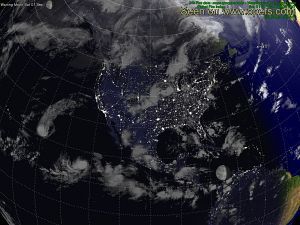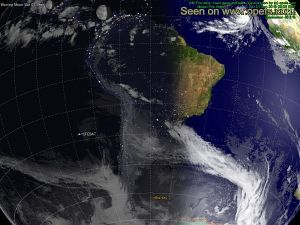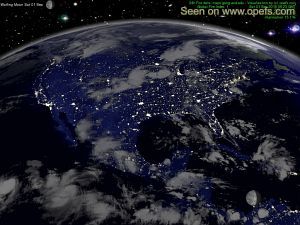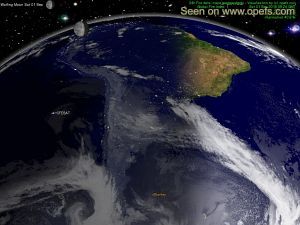Shown here is North America, the third largest continent in area and the fourth
ranked in population.
It is bounded on the north by the Arctic Ocean,
on the east by the North Atlantic Ocean, on the south by the Caribbean
Sea, and on the west by the North Pacific Ocean. It covers an area
of 9,355,000 square miles (24,230,000 square kilometres). In 2001
its population was estimated at 454,225,000.
South America is a continent crossed by the equator, with
most of its area in the Southern Hemisphere. South America is situated
between the Pacific Ocean and the Atlantic Ocean. It became attached
to North America only recently, geologically speaking, with the
formation of the Isthmus of Panama. The Andes, likewise a comparatively
young and seismically restless mountain range, run down the western
edge of the continent; the land to the east of the Andes is largely
tropical rain forest, the vast Amazon River basin.
This article is
licensed under the GNU
Free Documentation License. It uses material from
the Wikipedia articles North
America & South
America.
By now everbody's aware of how the Internet made the world smaller. What many of us isn't aware though, is that the Internet has also made huge strides on bringing the universe at the palm of our hands. Google Earth was a big first step. And soon if NASA's plan of bring live satellite feeds of different parts of the galaxy, we'll be able to sail among the stars without actually hooking up in astronaut suits and riding space shuttles. Not bad for a medium more popular for online poker and social networking 'ey? For now though, let's settle for these satellite photos of Earth.
Shown here is North America, the third largest continent in area and the fourth
ranked in population.
It is bounded on the north by the Arctic Ocean,
on the east by the North Atlantic Ocean, on the south by the Caribbean
Sea, and on the west by the North Pacific Ocean. It covers an area
of 9,355,000 square miles (24,230,000 square kilometres). In 2001
its population was estimated at 454,225,000.
South America is a continent crossed by the equator, with
most of its area in the Southern Hemisphere. South America is situated
between the Pacific Ocean and the Atlantic Ocean. It became attached
to North America only recently, geologically speaking, with the
formation of the Isthmus of Panama. The Andes, likewise a comparatively
young and seismically restless mountain range, run down the western
edge of the continent; the land to the east of the Andes is largely
tropical rain forest, the vast Amazon River basin.
This article is
licensed under the GNU
Free Documentation License. It uses material from
the Wikipedia articles North
America & South
America.
"Our
Planet Earth From Space":
self-updating screensavers &
wallpapers
(For Windows 98/ME/2000/XP) The screensavers and wallpapers are
self-updating at the start and then every 20 minutes. The free
versions are sponsored through per-click advertising.
Screensavers
and wallpapers are kind on your valuable computer resources:
all Memory- and CPU intensive image-processing is done on the
servers of "Our Planet Earth From Space".
|
|
 This
work is licensed under a
Creative
Commons Attribution-NonCommercial-ShareAlike 2.0 Germany License.
This
work is licensed under a
Creative
Commons Attribution-NonCommercial-ShareAlike 2.0 Germany License.



